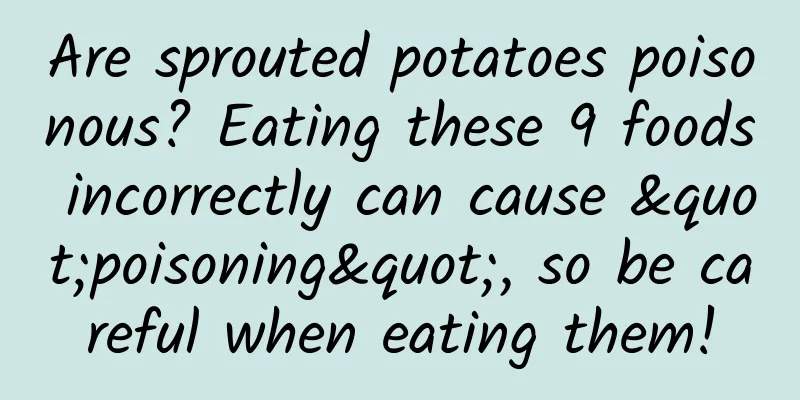Are sprouted potatoes poisonous? Eating these 9 foods incorrectly can cause "poisoning", so be careful when eating them!

|
Recently, the news #Girl fainted and was sent to the hospital after eating uncooked sprouted potatoes# became a hot topic. Ms. Li from Guangzhou, Guangdong did not notice that the potatoes had sprouted when she bought them, and she may not have cooked them thoroughly after returning home. Ten minutes after eating the potatoes, she suddenly felt dizzy and vomited, and fainted on the way to work. Passersby called an ambulance to send her to the hospital. So, are sprouted potatoes really poisonous? In life, poisoning caused by eating the wrong food is not uncommon. In this article, we will talk about those common "toxic" foods one by one. Be careful when eating them. Sprouted potatoes It is very common for potatoes to sprout. Once they sprout, you need to be extra vigilant. Potatoes with severe sprouting or whose degree of sprouting cannot be determined should never be eaten! Image source: Copyright Library This is because the content of solanine in potatoes will increase greatly after they sprout. This is a toxic glycoalkaloid. Under normal circumstances, the content of solanine in potatoes is very low, but after sprouting, the content of solanine will increase. Ingesting very small amounts of solanine is not toxic to the human body, but ingesting 200 mg of solanine at a time can cause poisoning [1]. The earliest symptoms of poisoning from eating sprouted potatoes are itching in the mouth and throat, pain in the upper abdomen, nausea, vomiting, diarrhea, etc.; those with more severe poisoning may suffer from dehydration, electrolyte imbalance, and low blood pressure due to severe vomiting and diarrhea; those with severe poisoning may also experience coma and convulsions, and may even suffer from heart failure, respiratory paralysis, and ultimately death. What does 200 mg of solanine mean? It is equivalent to about 30 grams of green or sprouted potatoes (about the amount of two thumbs). However, it does not mean that potatoes cannot be eaten if they sprout. If the potatoes have just started to sprout and are only in a small area, you can dig out the sprouting part and the area around the sprout eyes (make sure to dig deeper) and remove all the parts that have turned from purple to green. Then soak them in cold water for more than half an hour, discard the soaking water, and cook them thoroughly before eating. If the potatoes sprout to a serious degree, don't worry about it and just discard them. For potatoes with very slight sprouts, after removing the sprouted parts, they can be cooked by steaming or boiling, because the glycoalkaloid content of potatoes will be reduced by 65% in steam, while boiling can reduce it by more than 80%. Soaking in vinegar-water solution during the processing process can also reduce the solanine content. [1, 2] Although potato sprouts are poisonous and cannot be eaten, sprouts of sweet potatoes, beans, nuts, etc. are generally non-toxic and can be eaten. Uncooked soy milk Many people like to cook soy milk at home. If you use a small stew pot instead of a soy milk maker, you must be careful, as drinking uncooked soy milk may cause food poisoning. Image source: Copyright Library When cooking soy milk, false boiling may occur. This is because soy milk contains saponin, which will produce a lot of foam when heated to 80°C, giving the feeling that the soy milk is "boiling". At this point, the soy milk is not yet cooked and still contains harmful ingredients, such as saponins and antitrypsin. Saponins are irritating to the mucous membranes; they also contain saponins that can destroy red blood cells and cause poisoning; and they also contain a substance called urease, which can also cause human poisoning. [3] Generally, you will feel unwell half an hour to one hour after drinking it, mainly manifested as nausea, vomiting, abdominal distension, diarrhea, which may be accompanied by abdominal pain, dizziness, fatigue and other symptoms. In severe cases, it may even lead to death. To avoid poisoning, do not turn off the heat when you see a "false boil" when cooking soy milk. Instead, continue heating on low heat for 5 minutes. Wait until the foam disappears and it boils again before turning off the heat. Undercooked beans Image source: Copyright Library There are many cases of poisoning caused by eating undercooked beans, especially in collective canteens. Raw beans contain two substances: hemagglutinin and saponin. Hemagglutinin is also called bean extract or plant lectin. Hemagglutinin can strongly irritate the digestive tract, damage the digestive tract mucosa, and cause gastroenteritis. If it enters the blood, it can agglutinate with red blood cells, which is why it is named. After saponin enters the body, its hydrolysis product sapogenin can also irritate the gastrointestinal mucosa and cause an inflammatory response, which can cause symptoms such as nausea, vomiting, abdominal pain, and diarrhea. [4] This ingredient is afraid of heat. Heating at 100°C for more than 10 minutes, or frying at a higher temperature, can cleave saponins and eliminate the toxicity of harmful substances. Therefore, if beans are not cooked thoroughly, it is easy to cause poisoning. In addition to beans, green beans, sword beans, and lentils also contain saponins. Fresh daylily Fresh daylily cannot be eaten directly because certain ingredients in it can cause nausea, vomiting, dry mouth and diarrhea. Image source: Copyright Library As for what this ingredient is, previous studies have always believed that it is colchicine. After being absorbed by the gastrointestinal tract, colchicine is partially oxidized to dicolchicine, which can irritate the gastrointestinal tract and cause abdominal pain, vomiting, diarrhea and other gastrointestinal discomfort symptoms. After steaming and blanching, colchicine will be decomposed and can be safely consumed. [5] However, recent new research has put forward a different view on the "toxic components" in daylily. The new research believes that daylily does not contain colchicine, but rather a co-elution component of multiple compounds. It is easily soluble in water and can be decomposed by steaming and blanching. It is safe to eat after cooking. [5] No matter what this "toxic ingredient" is, don't eat it fresh. Make sure to steam or blanch it before eating. Long soaked fungus Don't soak black fungus for too long, let alone for two or three days. Black fungus that has been soaked for a long time is likely to produce fumonisin, a toxin produced by the genus Pseudomonas cereus. There is currently no specific antidote for fumonisin poisoning, and the mortality rate is over 40%. Image source: Copyright Library It is best to soak black fungus for less than 4 hours, and the water temperature should not be too high. Generally, 30°C is the most suitable temperature. Experiments have shown that when soaking for more than 6 hours, the edges of the black fungus will crack, which seriously affects the quality of the fungus and makes it more susceptible to microbial contamination. [6] Under normal circumstances, 5 grams of dried black fungus is enough for one person to eat at a time. If you soak too much at one time, you can blanch it in water, drain the water, and then wrap it in a fresh-keeping bag and refrigerate it in the refrigerator and eat it the next day. Beautiful mushrooms Many beautiful mushrooms may be "bad luck" and may be poisonous. For example, among the Amanita family, poisoning caused by Amanita phalloides ranks first, and Amanita phalloides and Amanita phalloides are the most common poisonings in the genus Amanita. Poisoning can cause liver damage and can be life-threatening in severe cases. Image source: Journal of Mycology [7] Even if you don't know poisonous mushrooms, don't eat mushrooms you haven't eaten before, don't pick mushrooms that look too good, and don't touch them out of curiosity. Just eat the safe mushrooms you know, such as shiitake mushrooms, enoki mushrooms, oyster mushrooms, king oyster mushrooms, chicken leg mushrooms, white jade mushrooms, matsutake mushrooms, hazel mushrooms, etc. Rotten ginger Ginger will rot and deteriorate if not stored properly. If you find that the ginger is rotten, do not eat it. The safrole content in ginger will greatly increase after it rots. It is a toxic substance and excessive intake is harmful to the liver. Bitter almonds Bitter almonds contain amygdalin , which will generate hydrocyanic acid after hydrolysis, which will make tissue cells unable to use the oxygen carried by red blood cells, causing tissue asphyxiation and cell toxic hypoxia. The effect on the central nervous system is first excitement and then paralysis. Respiratory paralysis is the main cause of death from hydrocyanic acid poisoning. Children eating 10 to 20 pills or adults eating 20 to 60 pills can cause poisoning. [8] In addition to bitter almonds, raw ginkgo nuts are also not to be eaten. Unprocessed puffer fish Many people love to eat puffer fish, which are delicious. However, eating this fish incorrectly can be fatal. Puffer fish contain tetrodotoxin, which is highest in the ovaries, liver, and intestines. Muscles mostly contain no toxin or only contain a small amount of toxin. However, the muscles of the chrysanthemum yellow puffer and the worm-patterned puffer are found to contain very high levels of tetrodotoxin. [9] Image source: Copyright Library Tetrodotoxin is one of the most potent neurotoxins among natural toxins, 1,250 times more potent than sodium cyanide. It is stable in toxicity and cannot be diluted even after being boiled or exposed to the sun. Tetrodotoxin has a strong paralytic effect on the central nervous system and peripheral nerves of the human body. It causes nerve paralysis and brainstem paralysis by acting on the nervous system, inducing respiratory failure and eventually leading to death. [10, 11] Improper handling of wild puffer fish can lead to poisoning. It is best not to eat wild puffer fish sold in the market, picked up puffer fish, or puffer fish caught by fishermen themselves. People who like to eat puffer fish are advised to choose farmed puffer fish. Studies have shown that the liver and blood of farmed puffer fish (red fin puffer fish, dark-striped puffer fish, chrysanthemum yellow puffer fish, and yellow fin puffer fish) are non-toxic or weakly toxic, and the muscles are non-toxic, so they can be eaten with confidence. [10] Conclusion: Although we are at the top of the food chain, we should not eat everything. Don’t let “delicious food” turn into “poisonous food”. To be a healthy foodie, be careful when eating the 9 foods mentioned above. References: [1]Xu Minhui, Liu Kewei, Zhang Xiaohui, et al. Research progress of solanine in potatoes[J]. Freshness and Processing, 2017, 017(001):112-116,121. [2] Wu Yashuai, Han Xuan, Zou Youyang, Wang Zongyi, Zhu Jingxin, Gao Xiuzhi. Research on effective methods to remove solanine from potatoes[J]. Journal of Food Safety and Quality, 2020, 11(05): 1514-1519. [5] Wang Yingrui, Zhang Yushi. Report on a case of death after eating dead river crabs[J]. Journal of Rare Diseases, 2015, v.22;No.113(06):65-66. [3] Li Huixia. Report on poisoning caused by drinking "fake boiling" soy milk[J]. Henan Journal of Preventive Medicine, 2011, 22(02):145. DOI:10.13515/j.cnki.hnjpm.2011.02.023. [4] Yang Mingfang, Chen Wei, Yi Yanzhong, Lu Zhenyu, Hu Jun. Laboratory analysis of a kidney bean saponin poisoning incident[J]. Chinese Journal of Health Laboratory Technology, 2018, 28(12): 1520-1522. [5] Ma Wei, Gao Jie, Xing Qian, Zhao Dan, Zheng Xiaonan, Jie Minchang. Safety analysis of fresh daylily[J]. Modern Food, 2021(23):153-155. DOI:10.16736/j.cnki.cn41-1434/ts.2021.23.045. [6] Ma Yinpeng, Du Boda, Zhang Jiechi, et al. Study on factors affecting the expansion rate of black fungus[J]. Edible Fungi, 2017, 39(004):62-65. [7] Tuligul, Bao Haiying, Li Yu. List of poisonous mushrooms in China[J]. Journal of Mycology, 2014, 33(03): 517-548. DOI: 10.13346/j.mycosystema.130256. [8] Wang Ling, Han Taohua. Analysis of 10 cases of bitter almond poisoning in children[J]. Chinese Journal of Birth and Child Health, 2012, 18(04): 253-254. [9] Sun Changhao. Nutrition and Food Hygiene 8th Edition[M]. People's Medical Publishing House. 2017:458 [10] Li Yunfeng, Ma Chenchen. Research on toxins in farmed pufferfish[J]. Journal of Food Safety and Quality, 2014, 5(03): 819-823. DOI: 10.19812/j.cnki.jfsq11-5956/ts.2014.03.034. [11] Wu Huamei, Chen Li, Fan Xiaofang. First aid and nursing care for puffer fish poisoning[J]. Chinese and Foreign Medical Research, 2017, 15(26): 62-63. DOI: 10.14033/j.cnki.cfmr.2017.26.032. Author: Xue Qingxin, registered nutritionist Review | Zhang Na, Associate Researcher, Doctoral Supervisor, Peking University School of Public Health The article is produced by "Science Refutes Facts" (ID: Science_Facts). Please indicate the source when reprinting. The pictures in this article are from the copyright gallery and are not authorized for reproduction. |
<<: Where is the most beautiful spring? 12 maps will tell you!
>>: From brushes to pixels: A brief introduction to the past and present of AI painting
Recommend
E-commerce operation logic of 8 major platforms including WeChat, Weibo, and Bilibili
In recent years, the competitive and cooperative ...
Private domain marketing plan for the medical beauty industry!
In this age where looks matter, appearance anxiet...
World No Tobacco Day | We have only heard of second-hand smoke, but where does third-hand smoke lurk?
□ Zhang Wenlou and Deng Furong May 31, 2024 is th...
Where is the lunar water reservoir? Chang'e 5 lunar soil samples provide clues →
Does the moon have a water reservoir? If so, wher...
Finally! It has been made clear: it is forbidden to make and publish videos of overeating, which is very harmful
It is shameful to waste food, and overeating is h...
2016 Ford Global Trends Report
We are entering an unprecedented new era. There a...
Monster Factory: Black and White Concept [HD]
Why should I learn grayscale coloring? Grayscale ...
User operation, how to increase user growth?
If you have a tactical way of thinking about prob...
No experience in short video advertising? The experienced driver will help you overtake on the curve!
This article mainly introduces the preparations b...
3 steps to effectively improve the user retention rate of your product!
After entering the stock market, user value becom...
What is nofollow? What does nofollow mean?
Many friends who are engaged in website SEO optim...
Apple hires hundreds of engineers to improve Siri
Apple launched HomePod in the US and other market...
Interstellar Odyssey: A Guide to the Solar System's Planets in 2024
(Image credit: Josh Dinner) How can we best see t...
AARRR model of user growth!
User growth is essentially a precise, low-cost an...









